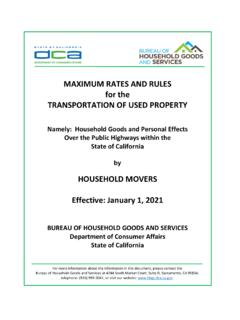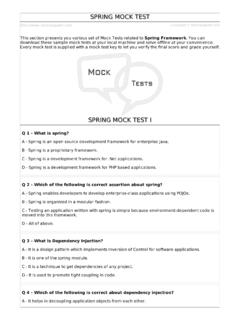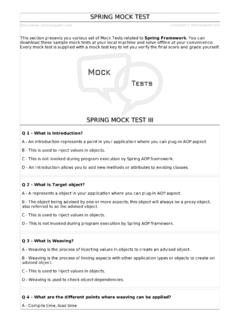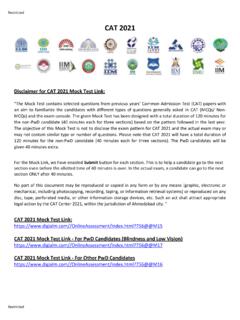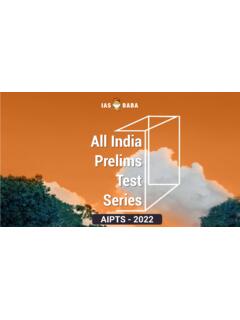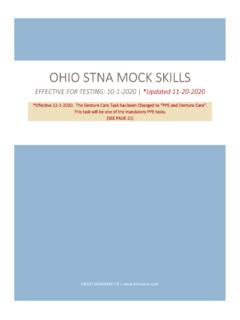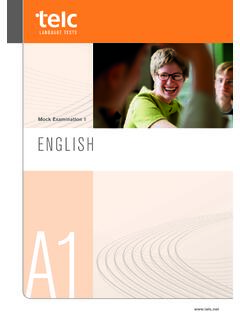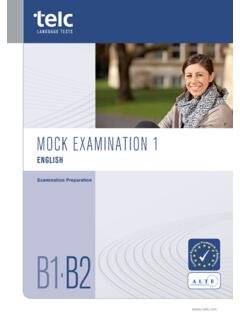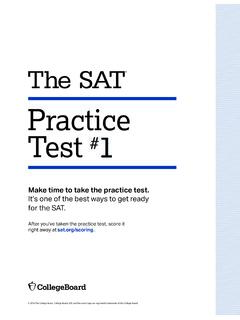Transcription of TECHNICAL BULLETIN 117-2013 - California
1 State of CaliforniaDepartment of Consumer Affairs BUREAU OF ELECTRONIC & APPLIANCE REPAIR HOME FURNISHINGS & THERMAL INSULATION 4244 SOUTH MARKET COURT, SUITE D SACRAMENTO, CA 95834-1243 TECHNICAL BULLETIN 117-2013 Requirements, Test Procedure and Apparatus for Testing the Smolder Resistance of Materials Used in Upholstered Furniture June 2013 REQUIREMENTS, TEST PROCEDURE AND APPARATUS FOR TESTING THE SMOLDER RESISTANCE OF MATERIALS USED IN UPHOLSTERED FURNITURE INTRODUCTION The intent of this standard is to produce upholstered furniture which is safer from the hazards associated with smoldering ignition. This standard provides methods for smolder resistance of cover fabrics, barrier materials, resilient filling materials, and decking materials for use in upholstered furniture. A. SCOPE is a fire-test-response standard. test methods are designed for the assessment of the resistance of upholstered furniture component assemblies to combustion after exposure to smoldering cigarettes under specified conditions.
2 tests apply to upholstered furniture components - cover fabrics, barrier materials, resilient filling materials, and decking materials. individual test methods and the materials to which they apply are as follows: Cover Fabric Test - Applies to outer cover fabrics. Materials Test - Applies to materials that are intended to serve as a barrier (interliner) between cover fabric and the resilient filling materials. Filling Material Test Applies to resilient filling materials used in upholstered seating furniture. Material Test Applies to resilient materials used in the deck under loose cushions. B. REFERENCED DOCUMENTS ASTM E1353-08a 1: Standard Test Method for Cigarette Ignition Resistance of Components of Upholstered Furniture (Addendum 1) Federal Specification CCC-C-436-E, Cloth, Ticking, Twill, Cotton; Type I. AATCC Test Method 124-2011: Smoothness Appearance of Fabrics after Repeated Home Laundering C.
3 TERMINOLOGY Obvious ignition - pronounced continuous and self-sustaining combustion of the test system accompanied by rapid generation of heat and smoke. It is a matter of operator judgment based upon experience in this type of operation. cover material - the outermost layer of fabric or related material used to enclose the main support system or upholstery materials, or both, used in the furniture item. (interliner) material - the first layer of material (film, fabric, batting or pad) that lies under the cover fabric in order to reduce smoldering propensity of the seating furniture. Resilient filling material - the resilient filling material in the form of batting, pads or loose fills used or intended to be used in an article of upholstered furniture. Deck in upholstered furniture, the upholstered support under the seat cushion in a loose seat construction. 1 D.
4 SUMMARY OF TEST METHOD These test methods consist of several tests used to evaluate the cigarette ignition resistance of upholstery cover fabrics, barrier (interliner) materials, resilient filling materials, and decking materials used in the manufacture of upholstered furniture. Each test involves a miniature assembly consisting of the component to be tested along with other specified materials, mounted on a plywood mock -up that resembles a small chair seat and back. The assembly is exposed to a lighted cigarette as an ignition source. E. SIGNIFICANCE AND USE These test methods are intended to estimate the performance of upholstered furniture under conditions of exposure to a smoldering cigarette. This is accomplished by testing furniture component assemblies. However, interactions between components in production furniture are not necessarily predicted by component assembly testing. These test methods are not intended to measure the performance of upholstered furniture under conditions of open flame exposure and do not indicate whether the furniture will resist the propagation of flame under severe fire exposure or when tested in a manner that differs substantially from the test standard.
5 The results obtained with a material component tested in mock -up, in accordance with these test methods, do not necessarily indicate the performance of the same material component in other geometrical configurations, such as in full size furniture. F. TEST FACILITY AND HAZARDS The exhaust system and hazards are described in Annex A. G. APPARATUS AND STANDARD TEST MATERIALS The apparatus and standard test materials are specified in Annex B and C. H. CONDITIONING Condition test specimens and cigarettes prior to the test for a minimum of 24 hours at 21 3 C (70 5 F) and less than 55% relative humidity. If conditions in the test area are not the same as in the conditioning area, tests should begin within 10 minutes of removal of samples from conditioning area. SECTION 1: COVER FABRIC TEST SCOPE This test method measures the tendency of upholstery cover fabrics to smolder and contribute to fire propagation, when subjected to a smoldering ignition source.
6 For cover fabrics that pass this section, the first layer of filling materials located below the cover fabric shall also meet the test requirements of section 3 of this test method. 2 TEST SPECIMEN Prepare the test specimens as specified in ASTM E1353-08a 1 (Section 10). TEST PROCEDURE Follow the test procedures of ASTM E1353-08a 1 (Section 11 Steps through ) and the additional test procedures specified below: : Place the specimen assembly directly on the fiberglass board. If testing multiple specimens simultaneously, place the individual test specimens at least 6 inches (152 mm) apart to avoid heat transfers between specimens. : After completing test procedure step , the test operators shall start timers to record testing time. PASS/FAIL CRITERIA A material is considered to pass or fail based on the following criteria: 1. A single mock -up test specimen fails to meet the requirements of this test procedure if any of the following criteria occurs: a) The mock -up test specimen continues to smolder after the 45 minute test duration; b) A vertical char length (measured as specified in step of ASTM E1353-08a 1) of more than inches (45 mm) develops on the cover fabric.
7 C) The mock -up test specimen transitions to open flaming. 2. The cover fabric passes the test if three initial mock -up specimens pass the test, , the cigarettes burn their full length and the mock -ups are no longer smoldering. 3. If more than one initial specimen fails, the cover fabric fails the test. 4. If any one of the three initial specimens fails, repeat the test on additional three specimens. 5. If all three additional specimens pass the test, the cover fabric passes the test. If any one of the additional three specimens fails, the cover fabric fails the test. SECTION 2. BARRIER MATERIALS TEST SCOPE This test method measures the tendency of the barrier material to smolder after exposure to smoldering cigarettes under specified conditions. Upholstery cover fabrics that fail the cover fabric test described in Section 1 can be used in upholstered furniture if a barrier (interliner) material that passes this test method is used.
8 When a barrier is required, the barrier material must cover all sides and top of the seating cushion(s). Exceptions: Non-reversible and non-detachable seating cushions do not require the use of the barrier material on the underside of the seating cushion. 3 TEST SPECIMENS : Cut three specimens, each 8 by 8 in. (203 by 203 mm) for horizontal panels from the material to be tested, and three specimens, each 8 by 12 in. (203 by 305 mm), for vertical panels. Note: The test material measurements for the vertical panels are different than ASTM (Section 20 step ). : Cut three specimens, each 8 by 8 in. (203 by 203 mm), from the Standard Type II cover fabric for horizontal panels, and three specimens, each 8 by 15 in. (203 by 381 mm), for vertical panels. Note: The fabric measurements for the vertical panels are different than ASTM (Section 20 step ). TEST PROCEDURE Prepare the test specimen as follows: For horizontal panels, place a barrier specimen on an 8 by 5 by 2 in.
9 (203 by 127 by 51 mm) polyurethane substrate. Fold the barrier around and under the polyurethane and fasten in place with pins. Place the 8 by 8 in. (203 by 203 mm) cover fabric over each barrier and fasten in place with pins. : For vertical panels, place a barrier specimen on an 8 by 8 by 2 in. (203 by 203 by 51 mm) polyurethane substrate. Place the 8 by 15 in. (203 by 381 mm) piece of cover fabric over each and fasten in place with pins. Note: The cover fabric measurement for the vertical panel is different than ASTM (Section 21 step ). Follow the test procedures of ASTM E1353-08a 1 (Section 21 - Steps through ) and the additional test procedures specified below: : Place the specimen directly on the fiberglass board. If testing multiple specimens simultaneously, place the individual test specimens at least 6 inches (152 mm) apart to avoid heat transfers between specimens. : After completing test procedure step , the test operators shall start timers to record testing time.
10 PASS/FAIL CRITERIA A material is considered to pass or fail based on the following criteria: 1. A single mock -up test specimen fails to meet the requirements of this test procedure if any of the following criteria occurs: a) The mock -up test specimen continues to smolder after the 45 minute test duration; b) A vertical char length (measured as specified in step of ASTM E1353-08a 1) of more than 2 inches (51 mm) develops on the cover fabric. c) The mock -up test specimen transitions to open flaming. 2. A barrier material passes the test if three initial mock -up specimens pass the test, , the cigarettes burn their full length and the mock -ups are no longer smoldering. 3. If more than one initial specimen fails, the barrier material fails the test. 4 4. If any one of the three initial specimens fails, repeat the test on additional three specimens. 5. If all three additional specimens pass the test, the barrier material passes the test.
